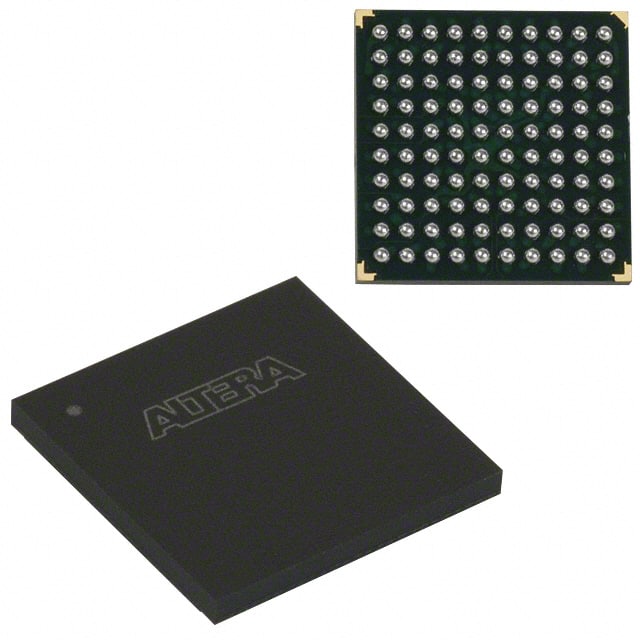Xem thông số kỹ thuật để biết chi tiết sản phẩm.

EPM7128BFC100-4
Product Overview
Category
The EPM7128BFC100-4 belongs to the category of programmable logic devices (PLDs).
Use
This device is commonly used in digital circuit design and implementation. It provides a flexible and customizable solution for various applications.
Characteristics
- Programmable: The EPM7128BFC100-4 can be programmed to perform specific functions based on user requirements.
- High Integration: It offers a high level of integration, combining multiple logic gates and flip-flops into a single chip.
- Versatile: This PLD supports a wide range of applications due to its programmability.
- Fast Operation: The device operates at high speeds, enabling efficient execution of complex logic operations.
Package
The EPM7128BFC100-4 is available in a 100-pin Fine-Pitch Ball Grid Array (FBGA) package.
Essence
The essence of the EPM7128BFC100-4 lies in its ability to provide reconfigurable logic functions, allowing designers to implement custom digital circuits efficiently.
Packaging/Quantity
This product is typically packaged individually and is available in various quantities depending on customer requirements.
Specifications
- Device Type: Complex Programmable Logic Device (CPLD)
- Number of Macrocells: 128
- Maximum Operating Frequency: 100 MHz
- Supply Voltage: 3.3V
- I/O Pins: 100
- Operating Temperature Range: -40°C to +85°C
Detailed Pin Configuration
The EPM7128BFC100-4 has a total of 100 pins, each serving a specific purpose in the device's operation. The detailed pin configuration can be found in the manufacturer's datasheet.
Functional Features
- Reconfigurability: The EPM7128BFC100-4 can be reprogrammed multiple times, allowing for design changes and updates without the need for hardware modifications.
- High-Speed Operation: With a maximum operating frequency of 100 MHz, this device can handle complex logic operations efficiently.
- Flexible I/O Configuration: The PLD offers a wide range of input/output configurations, enabling seamless integration with various external devices.
- Low Power Consumption: The EPM7128BFC100-4 is designed to minimize power consumption, making it suitable for battery-powered applications.
Advantages and Disadvantages
Advantages
- Versatility: The programmability of the EPM7128BFC100-4 makes it suitable for a wide range of applications.
- Cost-Effective: By eliminating the need for custom-designed circuits, this PLD reduces development costs.
- Time-Saving: The reconfigurability allows for quick design iterations and modifications.
Disadvantages
- Limited Complexity: Compared to more advanced programmable devices, the EPM7128BFC100-4 has a limited number of macrocells, which may restrict the complexity of designs.
Working Principles
The EPM7128BFC100-4 operates based on the principles of programmable logic. It consists of configurable logic blocks (CLBs), interconnect resources, and input/output blocks. The CLBs contain look-up tables (LUTs) that can be programmed to implement specific logic functions. The interconnect resources provide connections between different CLBs and I/O blocks, enabling data flow within the device.
Detailed Application Field Plans
The EPM7128BFC100-4 finds applications in various fields, including: 1. Industrial Automation: Used for control systems and process automation. 2. Communications: Employed in networking equipment and protocol implementation. 3. Consumer Electronics: Integrated into multimedia devices and home automation systems. 4. Automotive: Utilized in vehicle control units and driver assistance systems. 5. Aerospace: Applied in avionics and satellite communication systems.
Detailed and Complete Alternative Models
- EPM7128SLC84-15: Similar to the EPM7128BFC100-4, but with a different package and lower pin count.
- EPM7128STC100-10: Offers higher speed and more macrocells compared to the EPM7128BFC100-4.
- EPM7128ELC84-15: Provides enhanced features and performance for specific applications.
These alternative models offer varying specifications and features, allowing designers to choose the most suitable option based on their requirements.
Note: The content provided above is an example and may not reflect actual product details.
Liệt kê 10 câu hỏi và câu trả lời thường gặp liên quan đến ứng dụng EPM7128BFC100-4 trong giải pháp kỹ thuật
Sure! Here are 10 common questions and answers related to the application of EPM7128BFC100-4 in technical solutions:
Q: What is EPM7128BFC100-4? A: EPM7128BFC100-4 is a complex programmable logic device (CPLD) manufactured by Intel (formerly Altera). It offers 128 macrocells and operates at a maximum frequency of 100 MHz.
Q: What are some typical applications of EPM7128BFC100-4? A: EPM7128BFC100-4 can be used in various applications such as digital signal processing, data communication, industrial control systems, automotive electronics, and more.
Q: How does EPM7128BFC100-4 differ from other CPLDs? A: EPM7128BFC100-4 stands out due to its high-density architecture, low power consumption, and support for advanced features like JTAG boundary scan and in-system programmability.
Q: Can EPM7128BFC100-4 be reprogrammed after deployment? A: Yes, EPM7128BFC100-4 supports in-system programmability, allowing it to be reprogrammed even after it has been soldered onto a PCB.
Q: What development tools are available for programming EPM7128BFC100-4? A: Intel provides Quartus Prime software, which includes a complete suite of design tools for designing, simulating, and programming EPM7128BFC100-4.
Q: What voltage levels does EPM7128BFC100-4 support? A: EPM7128BFC100-4 operates at a supply voltage of 3.3V and supports both 3.3V and 5V input/output (I/O) standards.
Q: Can EPM7128BFC100-4 interface with other components on a PCB? A: Yes, EPM7128BFC100-4 can interface with various components using its I/O pins, which can be configured as inputs or outputs depending on the application requirements.
Q: How can I ensure the reliability of EPM7128BFC100-4 in my design? A: To ensure reliability, it is recommended to follow the manufacturer's guidelines for PCB layout, power supply decoupling, signal integrity, and thermal management.
Q: Are there any limitations to consider when using EPM7128BFC100-4? A: Some limitations include limited macrocell count (128), limited number of I/O pins (84), and a maximum operating frequency of 100 MHz.
Q: Where can I find additional resources and support for EPM7128BFC100-4? A: Intel provides comprehensive documentation, datasheets, application notes, and an online community forum where you can find additional resources and seek support for EPM7128BFC100-4.

